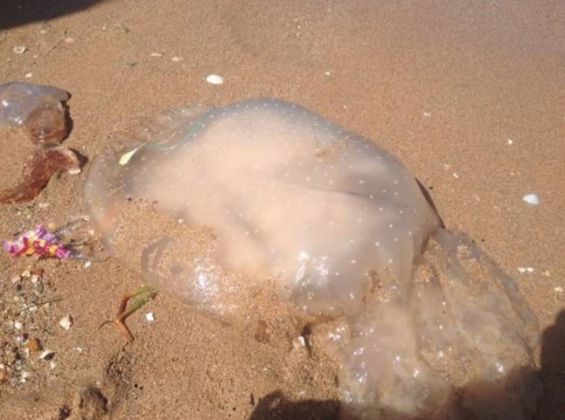Researchers in Morocco have discovered, for the first time, an alien species of jellyfish off the coast in the Mediterranean Sea. The see-through, bulbous creature with white polka-dots is, in fact, native to the Indo-Pacific oceans.
Phyllorhiza punctata, or the Australian jellyfish, is one of many alien sea creatures that have made their way to the Mediterranean, living thousands of nautical kilometers away from their native habitats.
A recent study conducted by a group of Moroccan and international scientists revealed that many plants and animals living in the ocean around Morocco aren't originally from there.
 Australian spotted jellyfish, Phyllorhiza punctata, observed on the coast of Nador, 3 August 2017. / Ph. Updating the national list of marine alien species in Morocco
Australian spotted jellyfish, Phyllorhiza punctata, observed on the coast of Nador, 3 August 2017. / Ph. Updating the national list of marine alien species in Morocco
The scientists discovered 46 creatures that came from elsewhere, and 15 more that might have. Most of these alien creatures (35), as scientists call them, are in the Mediterranean Sea, with fewer (16) in the Atlantic Ocean.
The most common type of visitor are seaweed-like plants (19), followed by shellfish (8), crustaceans (7), jellyfish-like creatures (5), fish (3), and sea squirts (2). There's only one worm and one segmented worm so far.
Hitching a ride on a ship
The Australian jellyfish is one of these permanent residents of the Mediterranean, likely a stowaway. In other words, the jellyfish likely hitched a ride on a ship to the Mediterranean.
«In the Mediterranean, the most common pathway is Transport-Stowaway, with 23 alien species having been likely introduced through two vectors, hull fouling or ballast water», according to the study.
Hull fouling is when sea creatures, like barnacles and mussels, cling onto the bottom of a ship. As the ship travels, these creatures hitch a ride to new oceans, becoming unwelcome visitors.
Ballast water is water taken in by large cargo ships to maintain stability. Tiny sea creatures can get sucked in with the water and end up in a whole new ocean when the tanks are emptied.
According to scientists, the Mediterranean seems to be home to more «permanent residents» (77%) from elsewhere compared to the Atlantic (69%).





 chargement...
chargement...













